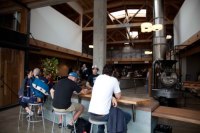design for service - spaces
And now for something completely different. If you interact with me (or my twitter feed) to any degree, you might’ve noticed…
coffee
— Aneel (@aneel) February 23, 2014
Drinking a Fantôme Saison D'Erezée - Hiver by Brasserie Fantme - http://t.co/bxo2Gmhoud
— Aneel (@aneel) February 24, 2014
I spend a fair bit of time in bars and coffee shops. Service in these places is interesting because although the formula seems straightforward--produce what’s ordered efficiently with sufficient pleasantness (or unpleasantness if very hip)--it’s multivariate and at least one of the variables is utterly uncontrollable. Skilled labor, number and type of staff on, complexity of menu factoring to time and consistency of production, complexity of menu factoring to time to educate and serve customers, work space, work space set up, service space, service space set up, customer space, customer space set up, steps to produce items, distance traveled to produce items, flow of customers in time and numbers (demand), flow of orders in time and numbers (demand), flow of orders vs complexity of orders (demand vs fulfillment), inventory location, inventory availability, staff incentives, margins, desired and prompted customer behavior, desired and prompted staff behavior, work space affordances, service space affordances, customer space affordances, etc.
We can design around everything except for demand. Coffee shops and bars can’t scale to meet demand infinitely. Service does not scale. Not in space, not in product, not in staff. There is no utility provision of beverage services [coffeops! beerops!] that underlies the actual production of product and servicing of customers for these businesses. So we have to find a service sweet spot in a normal operating range that can degrade gracefully during demand peaks and demand valleys.
But maybe we can create spaces and codes and empowerment that generally get one to the stateof good service experience. I think.
My favorite coffee shop in SF is Sightglass. My favorite beer bar here is MikkellerBar. Both are startups. Service at both is good-to-excellent most of the time. Under severe load or severe lack of load, interestingly enough, service at both degrades the same way: down decent-to-good.
Notice something similar?
Check out how much room there is behind the bar. More than a full complement of staff can move around and do everything necessary for service in their workspace without running into each other. You might also note that some key stations are mirrored on either side of both bars—sinks, points of sale, espresso machines. Neither place could operate effectively at high customer load without that sort of slack in physical space. Both places tend to have four people behind the bar when busy, plus a fifth and occasional sixth (usually a manager plus an extra pair of hands that were doing some other business). Sightglass will have a standard fifth to run the pour over station, while Mikkeller’s fifth is the shift manager helping out or waitstaff doing their own bar service. At both places, all staff seem to be trained to do all things and take up service backlog as needed, transitioning smoothly from function to function without stepping on each others’ toes.
In front of the bar, out in customerspace, there’s also a lot of slack. In the case of Mikkeller, since all parts of the bar that are not the bar itself are servicespace, that makes it relatively easy to navigate and get beer and food out promptly. In the case of Sightglass, most of the space is not servicespace but provides enough room for customers to get out of the way once they’ve ordered and not present navigation problems for each other. The upstairs at Sightglass is a servicespace for certain parts of the day and the same bit about slack holds there.
One final thing, look at how many different kinds of customerspace exist to afford different kinds of use: standing, sitting, alone or in groups or communal, in high or low traffic areas, face to face or face to service or face to space. For every kind of customer, a space.
P.S. Much of this thinking comes from time spent with industry people discussing the mechanics of service in the context of the needs of a business. They’ve been kind enough to tolerate my incessant curiosity. Thanks Dave, Paul, Tim and Jesse!









